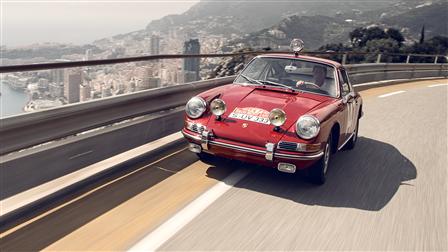The 911 was competitive in motorsports from the start; Walter Röhrl confirms its reputation to this day.
The first big race in a
In the early years of the brand, capable employees were given the chance to render outstanding service in two positions, such as racing director and press officer, technical specialist and race-car driver, or development engineer and codriver. Two functions were also envisaged for the model introduced in 1963, a 2+2-seat coupe with a six-cylinder boxer rear engine.
Huschke von Hanstein, who was both the racing director and the press officer, wanted to bring this double feat to the attention of the public. The racing calendar of early 1965 afforded him just one opportunity to do so—the Monte Carlo Rally.
The rally had the advantage of being international. And of having a final that appealed to von Hanstein as both press officer and racing director, namely, the drive up to the Prince’s Palace of Monte Carlo, made even more glamorous by the presence of Prince Rainier and his wife Gracia Patricia, the former Hollywood actress and luminescent star Grace Kelly.
The new, recently introduced
Rally stage routes in the French Maritime Alps took cars beneath cliffs and along gorges.
In the fall of 1964, Linge and Falk were sent on their first practice run for the rally, and they were able to drive the course a second time that year between Christmas and New Year’s. A fresh coupe was selected to be the vehicle for the race. Retaining its ruby-red paint job and the Pepita artificial leather interior considered elegant at the time, it was modified only slightly. The output of its two-liter six-cylinder engine was increased from the standard 130 hp (95 kW) to around 140–150 hp (103–110 kW), and its Solex carburetors were replaced by Webers. Linge wanted the gear lever to be moved back a little. The rest of the additions were standard rally equipment: rollover bar, Twinmaster, stopwatches, two extra front headlights, and the typical roof headlight of the time operated by the codriver. “We only used it to light up the road signs at night,” recalls Falk.
The usual traction aids for winter were installed at the rear: a pipe to stand on, and leather straps above the air grille for the codriver to hold. As if by plan, there was no end of snow in 1965, which turned the Monte Carlo Rally into a winter sport. After setting off from Bad Homburg for Chambéry, Linge and Falk had to fight their way through masses of snow in Holland, Belgium, and France. Falk reveals a tactic of the time: “We often just used the compass to drive in the snowstorms.”
Conditions really became serious in the French Maritime Alps, and when Linge once let the passenger side hit a wall of snow, Falk threw the roadbook onto the backseat in protest. But they followed von Hanstein’s orders and kept on driving the new 911 through the snow-induced chaos in southern France. “You absolutely have to drive the 911 up to the Prince’s Palace. That’s where the world’s press will be waiting.”
![[+]](https://files.porsche.com/filestore/image/multimedia/none/rd-2015-christophorus-issue372-article07-content-01/normal/b9c095f7-133d-11e5-bccb-001a64c55f5c/porsche-normal.jpg)
The roads have retained their rough original state, whereas the restored Monte Carlo 911 looks like new.
The two-liter six-cylinder boxer engine was given Weber carburetors; its fan wheel remained standard.
Linge and Falk had saved new Hakkapeliitta studded tires for the last night of the rally, when they would be driving over the notorious Col de Turini. But
As a reward, the two drivers were allowed to fly home, and the first
The effects of years of racing, obvious even from a distance, meant that only a complete restoration would have any hope of returning the car to its original brilliance. The new owner therefore decided to entrust the car to the only garage that offered a guarantee:
![[+]](https://files.porsche.com/filestore/image/multimedia/none/rd-2015-christophorus-issue372-article07-content-02/normal/39fa6bfb-133f-11e5-bccb-001a64c55f5c/porsche-normal.jpg)
Linge and Falk drove a production-based 911; among its relatively minor modifications were replacement fuses mounted on one of the steering wheel spokes.
After about two years of restoration work by
A complete restoration was required. The car needed to be taken apart and evaluated; new parts had to be procured and reinstalled. The Monte Carlo 911 was soon no more than an array of individual components, many of them doomed. When the body shell was back in shape, it was immediately given a cathodic dip coating, a process that had not even been invented in 1964. Hardly two years after restoration work started, the Monte Carlo 911 began its third incarnation almost exactly in time for its fiftieth anniversary: as good as new, in original form, yet enhanced by twenty-first-century advances in materials and processing.
The car’s timelessly elegant body exemplifies the legends and history of all of the 911 racing successes, including those achieved with what now seems like an enormous steering wheel and very soft seats without side supports. The newly chrome-plated housings of its extra headlights sparkle, and the light hue of the leather straps betrays their freshly cut state; but the Twinmaster driveshaft clicks like it did in 1965, and the two stopwatches on the passenger side display a genuine patina, at least to an appreciable degree.
Here and now, in the spring of 2015 to be precise, the nearly 50-year-old “new” 911 drives nimbly, even delicately, along the Côte d’Azur, with a master like four-time Monte Carlo Rally winner Walter Röhrl at the wheel. Röhrl enjoys the elegance and lightness—the car weighs less than 2,200 pounds when empty—on what used to be the rally stage routes through the Maritime Alps. He remarks on the car’s amazing agility on its narrow 165 tires, its compact turning radius, and its precisely tuned carburetors. And he recognizes the 911’s great potential for rally sports, “predicting” at least three overall victories in Monte Carlo by 1970. Which factory drivers Vic Elford and Björn Waldegård of course proceeded to fulfill.
By Eckhard Eybl
Photos by Achim Hartmann

![[+]](https://files.porsche.com/filestore/image/multimedia/none/rd-2015-christophorus-issue372-article07-margin-01/normal/bea76587-133c-11e5-bccb-001a64c55f5c/porsche-normal.jpg)
![[+]](https://files.porsche.com/filestore/image/multimedia/none/rd-2015-christophorus-issue372-article07-margin-02/normal/c61c80d0-133c-11e5-bccb-001a64c55f5c/porsche-normal.jpg)
![[+]](https://files.porsche.com/filestore/image/multimedia/none/rd-2015-christophorus-issue372-article07-margin-03/normal/79d06953-133e-11e5-bccb-001a64c55f5c/porsche-normal.jpg)
![[+]](https://files.porsche.com/filestore/image/multimedia/none/rd-2015-christophorus-issue372-article07-margin-04/normal/e1615767-133f-11e5-bccb-001a64c55f5c/porsche-normal.jpg)











